Salvation is a sacramental process situated solely within the body of Christ.
The Poison of Self-Identification
Western culture is obsessed with the individual. It’s commonplace these days to hear phrases like “my truth” or “I identify as …” pronounced boldly to the highest praise and adoration. We’ve enshrined in our legal precedents, notions such as:
“At the heart of liberty is the right to define one's own concept of existence, of meaning, of the universe, and of the mystery of human life." Planned Parenthood v. Casey, 505 U.S. 833 (1992)
The West treats the 'right' of self-identification as the highest of human endeavors and promotes, as the pinnacle of virtue, any action aimed at bringing about that identity in the world, consequences be damned. And if another should dare to disagree with, or in any way challenge, my personally constructed reality, my self-chosen identity, transient as it may be, they must be labeled a hatemonger for inflicting actual violence upon me.
As such, our entire lives now revolve around our individual preferences, proclivities, and the outward-facing identity we craft for ourselves without so much as a tacit recognition that we belong to our Creator, family, community, state, nation, or anything other than ourselves.
We have relegated ourselves to nothing more than an avatar, a thin caricature, a carefully crafted exterior with no substantive interior. Interestingly, the word avatar is a combination of two Sanskrit words meaning 'to descend' and 'to cross,' respectively.
In Hinduism, the connotation is something like the great condescension of our Lord, who became incarnate for us. But make no mistake, it is a purely pagan concept.
Remember the words of St. Paul to the Ephesians:
And you He made alive, who were dead in trespasses and sins, in which you once walked according to the course of this world, according to the prince of the power of the air, the spirit who now works in the sons of disobedience, among whom also we all once conducted ourselves in the lusts of our flesh, fulfilling the desires of the flesh and of the mind, and were by nature children of wrath, just as the others. Ephesians 2:1-3
The prince of the power of the air descends to work through us, who conduct ourselves in the lusts of our flesh. In those moments, we become the manifestation or incarnation of that same serpent who deceived the woman in the garden. Remember the words of our Lord:
You are of your father the devil, and the desires of your father you want to do. John 8:44
This obsession with self truly permeates all of Western culture including its "Christian" culture. There's a common belief out there among many in the myriad post-reformation Western Christian traditions that we are each individually"saved" in, through, and by the individualized acts of apprehension, faith, acceptance, and surrender to Jesus Christ. It’s as if the salvific power of Christ’s incarnation, death, and resurrection is wholly subsidiary to the personal surrender of the individual.
SPOILER ALERT: Jesus’ name means “Jehova is salvation.” Christ doesn’t merely offer us salvation; He, the God-man, the second Adam is the salvation of the human race. '
To put it another way, Christians in the West tend to think that there are only two persons involved in the process of Salvation: the Savior and the Savee. But this conception doesn't fit the pattern provided by traditional Christian teachings, or common sense. Instead, it's clear from the very beginning of creation that one human being alone with God is not good.

Man Needs a Helper
Even before sin entered the world, God looked upon the man He had made and, for the first time, found something that was not good.
And the Lord God said, It is not good that the man should be alone, let us make for him a help suitable to him. Genesis 2:18 (Brenton's Septuagint Translation)
The Masoretic text somewhat obscures what's happening here, which is why God states in most English translations, "I will make a helper..." Whereas, in the Greek Septuagint, God again speaks in the plural form as before, "Let us make..." This is important, as St. John Chrysostom explains:
" 'Let us make a human being in our image and likeness,' so now, too, on the point of forming woman he employs the same expression, saying, 'Let us make.' To whom does he address it? Not to any created power, but to the one begotten of him, Wonderful Counsellor, Figure of Authority, Prince of Peace, his only begotten Son. [ Isa 9:6 ] So that Adam may learn that the being in process of being formed is meant to enjoy equality of esteem with him, accordingly just as he said in the man's case, "'Let us make,'" so he now says also, 'Let us make him a helpmate like himself.' Both expressions, helpmate and like himself have much significance."
Saint Chrysostom helps us understand that God’s statement informs Adam (and us) that the creation of woman is just as sacred as that of man and that she is fully his equal in terms of her creation and purpose. The woman was taken from the man, yet was created by the same hands and received the same breath of life as he. She is part of him, not a separately created entity.
St. Ambrose of Milan likewise commented on the creation of woman from man stating:
"Accordingly, the Lord declared that i[t] was not good for man to be alone, because the human race could not have been propagated from man alone. God preferred the existence of more than one whom He would be able to save than to have to confine this possibility to one man who was free from error... Not without significance, too, is the fact that woman was made out of the rib of Adam. She was not made of the same earth with which he was formed, in order that we might realize that the physical nature of both man and woman is identical and that there was one source for the propagation of the human race. For that reason, neither was man created together with a woman, nor were two men and two women created at the beginning, but first a man and after that a woman. God willed it that human nature be established as one. Thus, from the very inception of the human stock He eliminated the possibility that many disparate natures should arise."
This is essential to understanding both what salvation is and its ultimate purpose. There is one human nature; one humanity. Man and woman united are indivisible elements of humanity.
“Male and female he created them, and he blessed them and named them Adam when they were created. Genesis 5:2
Without the woman, mankind could not propagate. But together, mankind could acquire true knowledge, not that of carnal union, but heavenly knowledge of the divine through communion. However, mankind chose to acquire knowledge, both good and evil, by consumption rather than communion.
Death, Curse, and the Means of Redemption
The trespass in the garden brought sin into the world and men began to “know” evil. Without communion with God, mankind communed with the evil one, who has no existence in himself (Genesis 6). The result of that communion is death (Romans 6:23).
“Therefore, just as sin came into the world through one man, and death through sin, and so death spread to all men because all sinned.” Romans 5:12
Not only did mankind separate itself from the source of life, God, but they also separated themselves from each other, creating an unnatural, yet undeniable need for hierarchy within the fundamental human relationship (Genesis 3:16). St. John Chrysostom explained God's intent for this:
As if to explain His reasons to the woman, the loving God said this, meaning, in the beginning, I created you equal in esteem to your husband, and my intention was that in everything you would share with him as an equal, and as I entrusted control of everything to your husband, so did I to you; but you abused your equality of status. Hence, I subject you to your husband... and designate him as your master for you to recognize his lordship, and since you did not know how to rule, learn well how to be ruled."
But, as we shall see, it was precisely this lovingly-imposed submission within the marital union that provided the opportunity for salvation. As St. Ambrose of Milan put it:
If the woman was to be the first one to sin, the fact that she was the one destined to bring forth redemption must not be excluded from the operations of Divine Providence. Although 'Adam was not deceived, the woman was deceived and was in sin.' [ 1 Tim 2:14 ] Yet woman, we are told, 'will be saved by childbearing,' in the course of which she generated Christ."
Let us then remember the perfect submission of the Virgin Mary to the will of her Lord delivered by the Archangel Gabriel:
And Mary said, 'Behold the handmaid of the Lord; be it unto me according to thy word.'" Luke 1:38
Two Lines Emerge
From the union of Adam and the woman he, in fervent hope for redemption, named Eve (the mother of all living), two lines emerged. First, the line of Cain (Genesis 4), the murderous and city-building developers of worldly technology, the result of which spurred the ever-deeper slide into non-existence.
Second, the line of Seth (Genesis 4-5), the nomadic sojourners in this world who began the development of spiritual technology, the result of which would lead to the redemption of man.
For we know that God “will render to each one according to his works: to those who by patience in well-doing seek for glory and honor and immortality, he will give eternal life; but for those who are self-seeking and do not obey the truth, but obey unrighteousness, there will be wrath and fury.” (Romans 2:6-8)
And so, death “reigned from Adam to Moses, even over those whose sinning was not like the transgression of Adam, who was a type of the one who was to come.” (Romans 5:14) And yet, amidst such evil, there remained a remnant, Noah, who “found favor in the eyes of the Lord” (Genesis 6:8) on account of his faith, by which he “condemned the world and became an heir of the righteousness that comes by faith.” (Hebrews 11:7)
Therefore, as one trespass led to condemnation for all men, so one act of righteousness leads to justification and life for all men. For as by the one man's disobedience the many were made sinners, so by the one man's obedience the many will be made righteous.” Romans 5:18-19
God Saves by Arks
Instead of saving people individually from the fall of mankind, God used a series of arks to preserve them as groups and established covenants with them, simultaneously redeeming and re-establishing the relationship that had been broken.
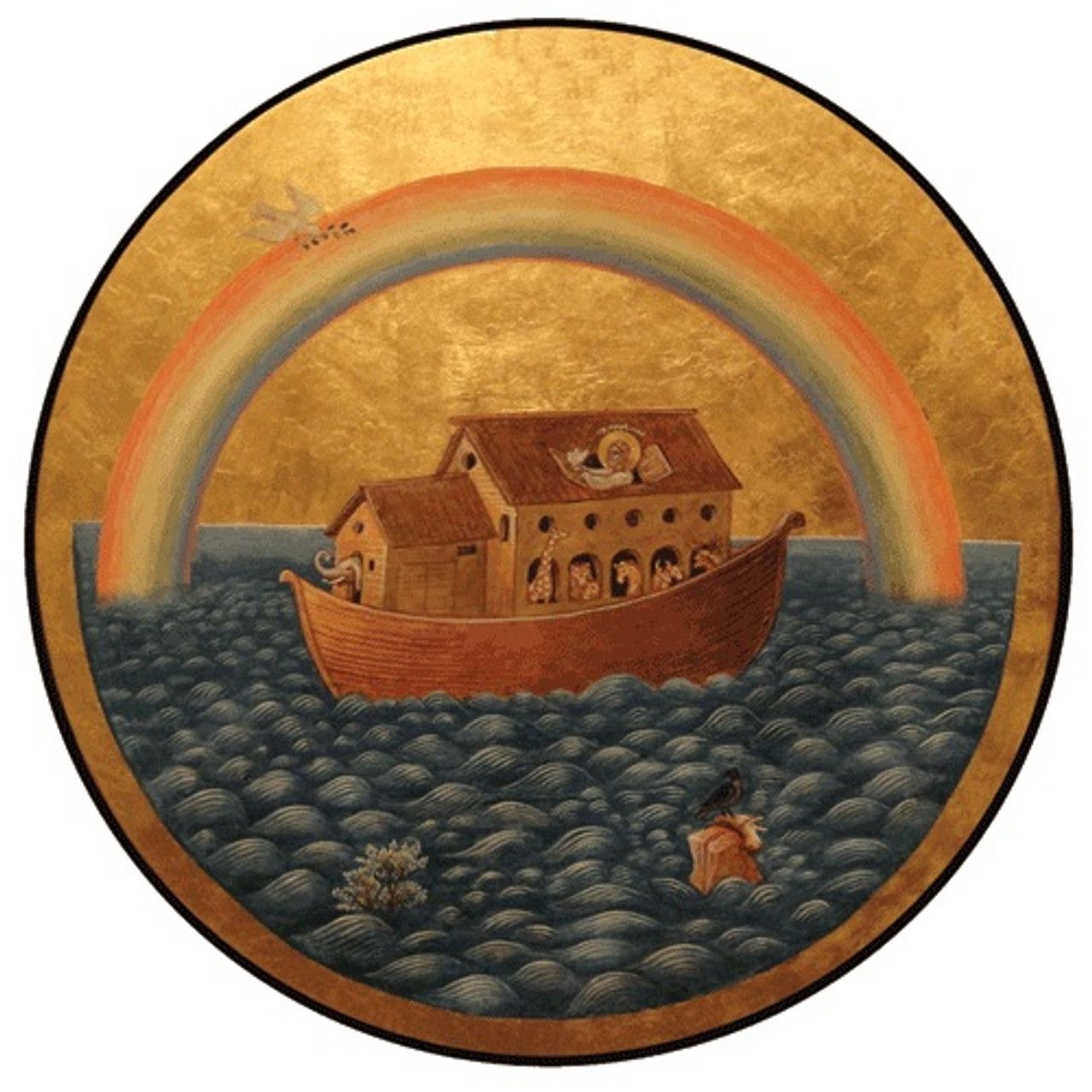
When sin flooded the world such that God sighed (Genesis 6:6), He instructed Noah to build an ark (Genesis 6:14) by which He delivered Noah, his family, and the animals from the waters of chaos and judgment. This 'baptism' temporarily cleansed the pollution of evil in the world. (Genesis 6:18).
When evil swallowed up the descendants of promise, God preserved baby Moses from Pharoh’s murderous decree in an ark made of tar and papyrus, so that through Moses He could both judge Egypt and deliver the entire people of Israel into the promised land where He would once again dwell with mankind. (Exodus 2-14).
When the Israelites, who had been freed from their bondage, desired and agreed to live with God, He had them build the Ark of the Covenant, above which He spoke to the people from atop the cherubim, upon which sat the mercy seat where atonement was made, in which rested the testimony (Word) of God, that is, the tablets of the law written by the finger of the pre-incarnate Christ and manna in a golden bowl, and by which the Israelites were lead across the Jordan river, not unto their rest but unto battle against the powers of darkness. (Exodus 23-25, 31:18, Joshua 3, Ephesians 6:12, and Hebrews 9:4).
Joshua 3:15-16 states that when the ark of the covenant crossed over the river Jordan, the waters rolled up in "a solid wall of water over a very great distance, as far as the region of Adam." St. Paulinas of Nola observes that the waters of the Jordan “recoiled from the countenance of the divine ark.” This foreshadows the complete redemption of Christ’s work on the cross.
And the LORD said unto Joshua, This day will I begin to magnify you in the sight of all Israel, that they may know that, as I was with Moses, so I will be with you.” Joshua 3:7
The passage foreshadows Jesus’ (whose name in Hebrew is Joshua) transfiguration, in which Moses and Elijah were seen, as well as Theophany (Christ’s baptism in the Jordan). In both instances, a voice was heard from heaven saying, “This is My beloved Son, with whom I am well pleased” (Matthew 3, 17, Mark 1).
Speaking of Christ’s baptism in the Jordan, St. Ambrose of Milan states:
“Scripture tells of many wonders wrought at various times in [the Jordan]; as that, among others, in the Psalms, “Jordan was driven backwards;” before the water was driven back, now sins are turned back in its current; as Elijah divided the waters of old [2Kings 2:8], so Christ the Lord wrought in the same Jordan the separation of sin.”
The torrent of sin raging from the fall of man was driven back all the way to Adam in the presence of the holiness of God manifested by the Ark of the Covenant. However, as soon as the Ark itself passed over the river bed the river immediately began to flow again (Joshua 4:18), signifying the inability of the law to take away the sins of the world. A greater Ark was needed; a greater covenant was necessary to fully redeem that which had been lost (Hebrews 10).
The Ark of the Virgin
As noted earlier by St. Ambrose, though a woman brought sin into the world, a woman would also bring forth man's salvation. A holy womb provided the space wherein God took flesh and dwelt among us. (John 1:14)
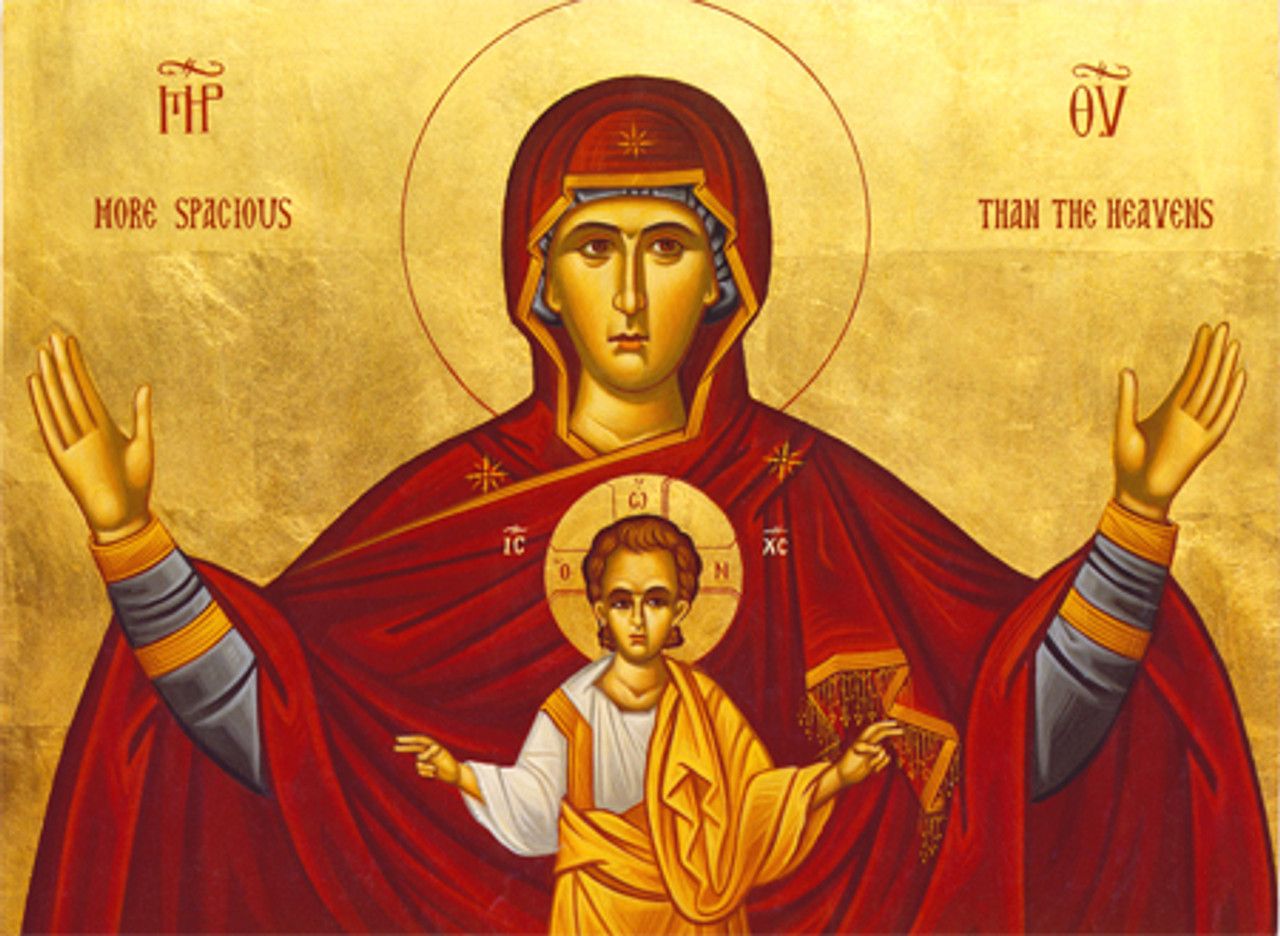
Many New Testament scriptures about the Virgin Mary mirror the Old Testament scriptures about the Ark of the Covenant. This is no coincidence. When the pregnant Mary meets her cousin Elizabeth, Elizabeth greets her saying,
“And why is this granted to me that the mother of my Lord should come to me?” Luke 1:43
This mirrors the statement of King David meeting the Ark of the Covenant in the Old Testament:
“How can the ark of the Lord come to me?” 2 Samuel (2 Kingdoms) 6:9
King David’s statement is not one of joy but of fear, for Uzzah had died for trying to steady the Ark as it was pulled by oxen. The Ark was not taken to David but to the house of Obed-edom, where it remained for three months, just as the Virgin Mary remained in the house of Elizabeth for three months (2 Samuel 6:11; Luke 1:56).
And just as David, wearing an ephod (a priestly garment), danced before the Ark, so St. John the Baptist, a prophet of the line of Aaron, danced in Elizabeth’s womb when the Virgin Mary arrived bearing the Incarnate Word (2 Samuel 6:14; Luke 1:41-42), and the bread of life (John 6:35).
Finally, St. Hippolytus (c. 170 - c. 236) explicitly connects the Virgin Mary with the Ark of the Covenant:
At that time, the Savior coming from the Virgin, the Ark, brought forth His own Body into the world from that Ark, which was gilded with pure gold within by the Word, and without by the Holy Ghost.
The Church is the Ark of Salvation
But the story doesn't stop there. While Mary is the Ark of the New Covenant, the Church is the Ark of Salvation upon which the faithful are brought safely to the harbor of the New Jerusalem.
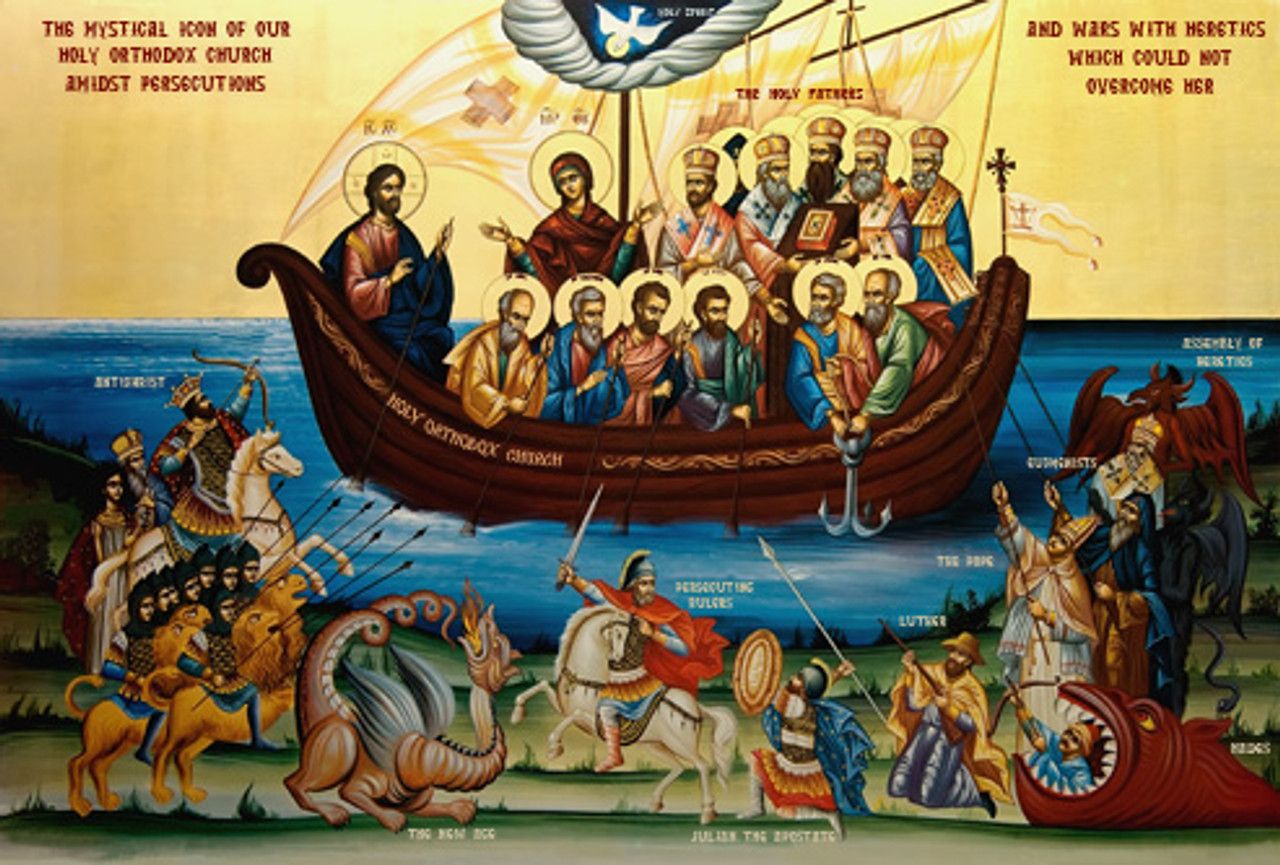
St. Peter makes this connection in 1 Peter 3:20-21 where he describes Noah's ark as that vessel in which "eight souls were saved through water."
There are a couple of important things to unpack here. First, Noah's name means "rest." Thus, for Noah to enter the Ark indicates the ‘rest’ that the people of God experience by entering the Church. And secondly, St. Peter says that they weren't saved from the water, but "through water." This is important because he connects the water with baptism, the sacrament through which we, being re-born, become members of the Church (Matthew 28:19).
Saint Nikolai Velimirovich writes:
"The flood of madness and sin continues incessantly. Therefore, the Lover of Mankind constructed the Ark of Salvation. Ask for this Ark, and you will soon be entering it. Do NOT let yourselves be led astray by the multitude of variegated vessels, decorate and adorned on the outside. Ask about the power of the engine and about the skill of the captain. The most powerful engine and the most skilled Helmsman are to be found in the Ark of Christ. This is the All-Seeing, All-Powerful, Holy Spirit Himself."
Moreover, the Gospel according to St. John tells us that "Jesus Himself did not baptize, but his Disciples." (John 4:2). So we know that from the very beginning, entrance into the Church was not a one-0n-one transaction. It involved a community. No, we are not saved alone, we are saved within the context of the Church, which Christ founded, and by which we have direct access to the uncreated energies (or grace) of God through the sacraments.
And just as Noah's companions were family, so are all who enter the Ark of Salvation (Romans 8:17).
On my own I am not the Church, but together with you. All together we are the Church. All are incorporated in the Church. We are all one and Christ is the head. -St. Porphyrios (Wounded by Love, p. 89)
The Mystical Marriage
Because Christ is both fully God and fully man, the Divine declaration that "[i]t is not good that man should be alone" (Genesis 2:18) applies also to Him. While God provided the first Adam a companion taken from his side, so Christ, the second Adam (1 Corinthians 15:45), created Himself a bride, the Church, from His side. (Ephesians 5:30-32).
The Midnight Office of Pascha, Ode 5, describes it this way:
Coming forth from an unwedded Mother, and wounded in the side with a spear, O my Maker, Thou hast brought to pass the re-creation of Eve...
When the Roman soldier pierced Christ's side with a spear, blood and water immediately sprang forth (John 19:34). The water represents baptism and blood represents the Eucharist, both of which flowed from the greater Tabernacle "not made with hands" (Hebrews 9:11, 10:20). The waters of baptism make us new creations (2 Corinthians 5:17) and Christ's blood is the new covenant of everlasting Life (Matthew 26:28, 1 Corinthians 10:16, Leviticus 17:11).
Moreover, Christ and his bride, the Church, are fully united, sharing not only in Christ’s Humanity but also in His Divinity, since Christians are, through grace, "partakers in the Divine nature" (2 Peter 1:4). St. Cyril of Alexandria says of this:
"Christ, having taken as an example and image of that indivisible love, accord and unity which is conceivable only in unanimity, the unity of essence which the Father has with Him and which He, in turn, has with the Father, desires that we too should unite with each other; evidently in the same way as the Consubstantial, Holy Trinity is united so that the whole body of the Church is conceived as one, ascending in Christ through the fusion and union of two people into the composition of the new perfect whole. The image of Divine unity and the consubstantial nature of the Holy Trinity as a most perfect interpretation must be reflected in the unity of the believers who are of one heart and mind.”
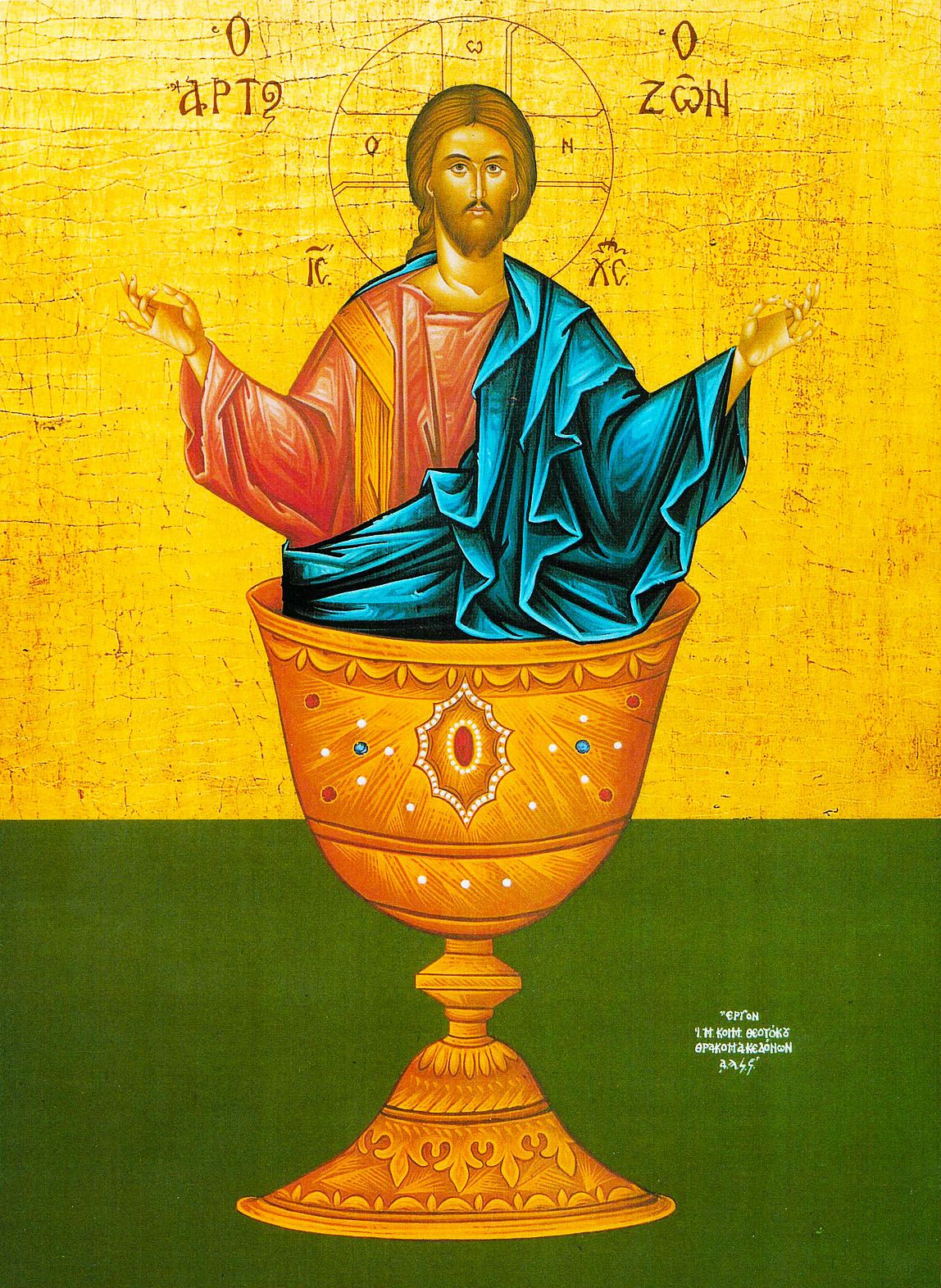
Now the words "[t]his is now bone of my bone, and flesh of my flesh" (Genesis 2:23) take on new and more profound meaning. They signify, not only the union of a man and his wife but the consubstantiality of all Christians through the mystical union of Christ with the Church, whereby we partake of the fruit of the tree of Life, "the true Vine" (John 15:1), the Body and Blood of Christ which is found only within the belly of the One Holy Catholic and Apostolic Church, where new life is formed and lives forever.
Amen.
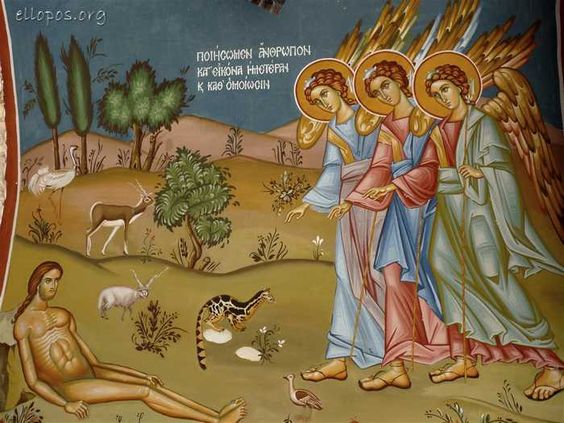

Member discussion: